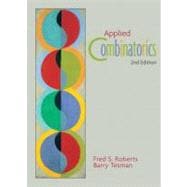
Note: Supplemental materials are not guaranteed with Rental or Used book purchases.
Purchase Benefits
What is included with this book?
| What Is Combinatorics? | |
| Basic Counting Rules | |
| Introduction to Graph Theory | |
| Generating Functions and Their Applications | |
| Recurrence Relations | |
| The Principle of Inclusion and Exclusion | |
| The Polya Theory of Counting | |
| Experimental Design | |
| Coding Theory | |
| Existence Problems in Graph Theory | |
| Matching and Covering | |
| Optimization Problems for Graphs and Networks | |
| Table of Contents provided by Publisher. All Rights Reserved. |
The New copy of this book will include any supplemental materials advertised. Please check the title of the book to determine if it should include any access cards, study guides, lab manuals, CDs, etc.
The Used, Rental and eBook copies of this book are not guaranteed to include any supplemental materials. Typically, only the book itself is included. This is true even if the title states it includes any access cards, study guides, lab manuals, CDs, etc.